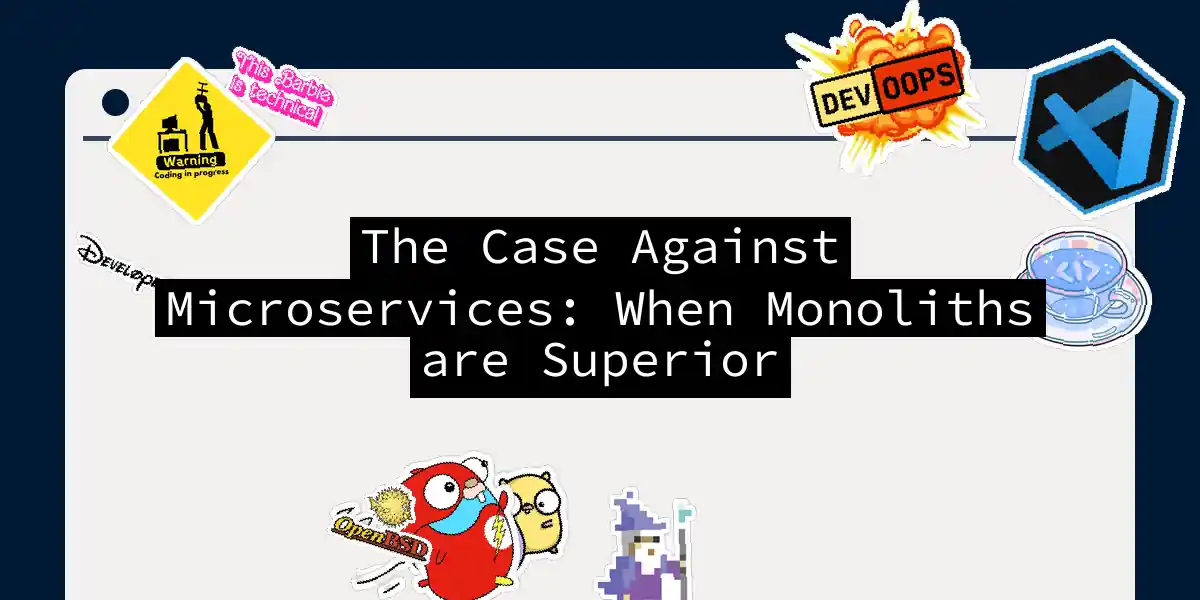The Microservices Mirage: Why Monoliths Might Be Your Best Bet
In the ever-evolving landscape of software development, the debate between microservices and monolithic architectures has been a longstanding one. While microservices have been touted as the silver bullet for scalability and agility, there are compelling reasons to believe that, in many cases, monoliths are the superior choice. Let’s dive into the nitty-gritty of why microservices might not be the panacea they’re often made out to be.
The Allure of Microservices: A Closer Look
Microservices promise a world of modular, scalable, and fault-tolerant systems. Each service operates independently, allowing for rapid deployment, updates, and scaling without affecting the entire application. Sounds too good to be true? Well, it often is.
The Complexity Conundrum
One of the primary pitfalls of microservices is the exponential increase in complexity. With multiple services, each with its own deployment, testing, and monitoring requirements, the overhead can be overwhelming. This is particularly evident in the context of debugging, where a single business process can span multiple services, making it a nightmare to identify and fix issues.
In the above sequence diagram, a simple request can involve multiple services and a database, highlighting the complexity of interactions in a microservices architecture.
The Monolithic Advantage
Monolithic architectures, on the other hand, are often maligned but offer several advantages that make them a more practical choice for many projects.
Simplicity and Speed
Monoliths are inherently simpler. All components are part of a single, unified unit, which means fewer network calls and less overhead in terms of deployment and maintenance. This simplicity translates into faster development cycles and easier debugging. When you need to make a change, you don’t have to navigate through a maze of services; you just modify the relevant part of the codebase and deploy the entire application.
Performance and Efficiency
Monolithic applications generally perform better because all components are housed within a single unit. This reduces the latency associated with network calls between different services. For example, Amazon’s Prime Video team found that moving from a microservices architecture to a monolith reduced their infrastructure costs by over 90% and improved performance significantly.
When to Choose Monoliths
So, when should you opt for a monolithic architecture over microservices?
Early Stages of Development
Starting a new project with microservices can be a recipe for disaster. The initial design is rarely fully optimized, and the first few iterations are spent figuring out what users really need. Monoliths allow for quicker iterations and easier refactoring during these critical early stages.
Small to Medium-Sized Projects
For smaller projects or those with a single development team, monoliths are often the better choice. They eliminate the unnecessary complexity that comes with microservices, allowing developers to focus on delivering business outcomes rather than managing a distributed system.
Modularization Over Microservices
If your monolith is becoming unwieldy, consider modularization instead of breaking it down into microservices. Shopify, for instance, has shown that sound engineering practices can make a monolith scale efficiently. By modularizing the codebase, you can achieve many of the benefits of microservices without the added complexity.
In this graph, we see how a monolith can be modularized and then scaled using various techniques, avoiding the need for a full microservices architecture.
Best Practices for Avoiding the Microservices Trap
If you’re still tempted by the allure of microservices, here are some best practices to keep in mind:
Focus on Outcomes, Not Trends
Don’t adopt microservices just because they’re trendy. Understand how an architecture adds value and its trade-offs. Align your IT organization structure with your business design, and ensure that the marginal benefit of decomposition outweighs the marginal cost of added complexity.
Avoid Little Balls of Mud
Replacing a big ball of mud (a monolith) with distributed little balls of mud (microservices) will only make things worse. Ensure that each microservice is correctly sized and aligned with your business design, rather than just breaking down the monolith into smaller pieces without a clear strategy.
Hybrid Approach
Sometimes, the best approach is a hybrid one. Combining the scalability of microservices with the efficiency of a monolith can offer the best of both worlds. This approach allows for easier updates, better fault tolerance, and enhanced system reliability.
Conclusion
In conclusion, while microservices have their place in the world of software development, they are not the universal solution they are often made out to be. Monoliths, with their simplicity, performance, and ease of maintenance, are often the superior choice, especially for smaller projects or during the early stages of development.
So, the next time you’re tempted to jump on the microservices bandwagon, take a step back and consider whether a monolith might be the better fit for your project. After all, as the saying goes, “if it ain’t broke, don’t fix it” – and sometimes, that monolith just isn’t broken enough to warrant the complexity of microservices.
